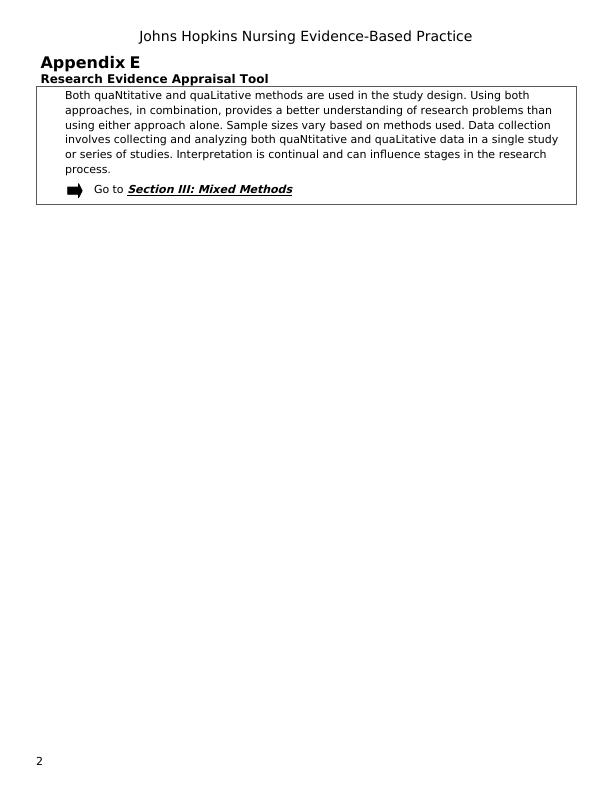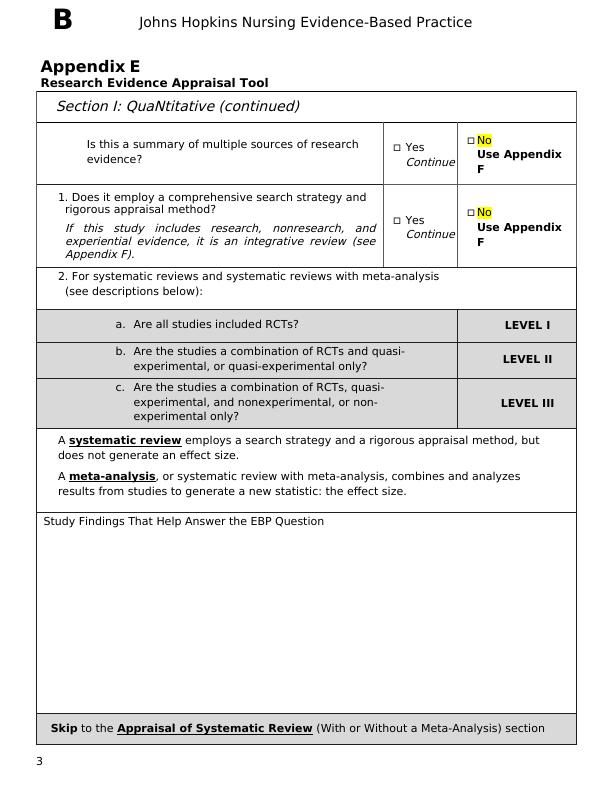Evidence Level and Quality Appendix E Research Evidence Appraisal Tool Page 6 of 10 Johns Hopkins Nursing Evidence-Based Practice Appendix E Research Evidence Appendix E Research Evidence Appraisal To
Added on 2022-08-16
11 Pages2786 Words240 Views
Johns Hopkins Nursing Evidence-Based Practice
Appendix E
Research Evidence Appraisal Tool
Evidence level and quality rating:
Article title: Attitudes: Mediators of the Relation between Health
and Driving in Older Adults
Number: 35 (S1)
Author(s): Holly Tuokko, Paweena Sukhawathanakul, Laura
Walzak, Alexandra Jouk, Anita Myers, Shawn Marshall, Gary
Naglie, Mark Rapoport , Brenda Vrkljan , Michelle Porter,
Malcolm Man-Son-Hing , Barbara Mazer, Nicol Korner-Bitensky,
Isabelle Gélinas, and Michel Bédard on behalf of the Candrive
II Research Team
Publication date: 05 / 15
Journal: Canadian Journal on Aging
Setting: Canadian Driving Research Initiative for Vehicular
Safety in the Elderly (Candrive) II study cohort
Sample (composition and size):
988, 70 years and more,
Canadian Driving Research
Initiative for Vehicular Safety in
the Elderly (Candrive) II study
cohort
Does this evidence address my EBP question?
Yes
No-
Do not proceed with appraisal of this evidence
Is this study:
QuaNtitative (collection, analysis, and reporting of numerical data)
Measurable data (how many; how much; or how often) used to formulate facts, uncover
patterns in research, and generalize results from a larger sample population; provides
observed effects of a program, problem, or condition, measured precisely, rather than
through researcher interpretation of data. Common methods are surveys, face-to-face
structured interviews, observations, and reviews of records or documents. Statistical tests
are used in data analysis.
Go to
Section I: QuaNtitative
QuaLitative (collection, analysis, and reporting of narrative data)
Rich narrative documents are used for uncovering themes; describes a problem or
condition from the point of view of those experiencing it. Common methods are focus
groups, individual interviews (unstructured or semi structured), and
participation/observations. Sample sizes are small and are determined when data
saturation is achieved. Data saturation is reached when the researcher identifies that no
new themes emerge and redundancy is occurring. Synthesis is used in data analysis.
Often a starting point for studies when little research exists; may use results to design
empirical studies. The researcher describes, analyzes, and interprets reports, descriptions,
and observations from participants.
Go to
Section II: QuaLitative
Mixed methods (results reported both numerically and narratively)
1
Appendix E
Research Evidence Appraisal Tool
Evidence level and quality rating:
Article title: Attitudes: Mediators of the Relation between Health
and Driving in Older Adults
Number: 35 (S1)
Author(s): Holly Tuokko, Paweena Sukhawathanakul, Laura
Walzak, Alexandra Jouk, Anita Myers, Shawn Marshall, Gary
Naglie, Mark Rapoport , Brenda Vrkljan , Michelle Porter,
Malcolm Man-Son-Hing , Barbara Mazer, Nicol Korner-Bitensky,
Isabelle Gélinas, and Michel Bédard on behalf of the Candrive
II Research Team
Publication date: 05 / 15
Journal: Canadian Journal on Aging
Setting: Canadian Driving Research Initiative for Vehicular
Safety in the Elderly (Candrive) II study cohort
Sample (composition and size):
988, 70 years and more,
Canadian Driving Research
Initiative for Vehicular Safety in
the Elderly (Candrive) II study
cohort
Does this evidence address my EBP question?
Yes
No-
Do not proceed with appraisal of this evidence
Is this study:
QuaNtitative (collection, analysis, and reporting of numerical data)
Measurable data (how many; how much; or how often) used to formulate facts, uncover
patterns in research, and generalize results from a larger sample population; provides
observed effects of a program, problem, or condition, measured precisely, rather than
through researcher interpretation of data. Common methods are surveys, face-to-face
structured interviews, observations, and reviews of records or documents. Statistical tests
are used in data analysis.
Go to
Section I: QuaNtitative
QuaLitative (collection, analysis, and reporting of narrative data)
Rich narrative documents are used for uncovering themes; describes a problem or
condition from the point of view of those experiencing it. Common methods are focus
groups, individual interviews (unstructured or semi structured), and
participation/observations. Sample sizes are small and are determined when data
saturation is achieved. Data saturation is reached when the researcher identifies that no
new themes emerge and redundancy is occurring. Synthesis is used in data analysis.
Often a starting point for studies when little research exists; may use results to design
empirical studies. The researcher describes, analyzes, and interprets reports, descriptions,
and observations from participants.
Go to
Section II: QuaLitative
Mixed methods (results reported both numerically and narratively)
1

Johns Hopkins Nursing Evidence-Based Practice
Appendix E
Research Evidence Appraisal Tool
Both quaNtitative and quaLitative methods are used in the study design. Using both
approaches, in combination, provides a better understanding of research problems than
using either approach alone. Sample sizes vary based on methods used. Data collection
involves collecting and analyzing both quaNtitative and quaLitative data in a single study
or series of studies. Interpretation is continual and can influence stages in the research
process.
Go to
Section III: Mixed Methods
2
Appendix E
Research Evidence Appraisal Tool
Both quaNtitative and quaLitative methods are used in the study design. Using both
approaches, in combination, provides a better understanding of research problems than
using either approach alone. Sample sizes vary based on methods used. Data collection
involves collecting and analyzing both quaNtitative and quaLitative data in a single study
or series of studies. Interpretation is continual and can influence stages in the research
process.
Go to
Section III: Mixed Methods
2

Johns Hopkins Nursing Evidence-Based Practice
Appendix E
Research Evidence Appraisal Tool
Section I: QuaNtitative
Level of Evidence (Study Design)
Is this a report of a single research study? Yes No
Go to B
1. Was there manipulation of an independent variable? Yes No
2. Was there a control group? Yes No
3. Were study participants randomly assigned to the
intervention and control groups? Yes No
If Yes to questions 1, 2, and 3, this is a randomized controlled trial
(RCT) or experimental study.
LEVEL I
If Yes to questions 1 and 2 and No to question 3 or Yes to question
1 and No to questions 2 and 3, this is quasi-experimental.(Some degree of investigator control, some manipulation of an
independent variable, lacks random assignment to groups, and may have
a control group).
LEVEL II
If No to questions 1, 2, and 3, this is nonexperimental.(No manipulation of independent variable; can be descriptive,
comparative, or correlational; often uses secondary data).
LEVEL III
Study Findings That Help Answer the EBP Question: The findings obtained by Tukko et al.,
(2016), indicated that negative attitudes regarding one’s health or driving were the
mediators influencing one’s perceptions regarding one’s health as well as associated driving
behaviors. Interestingly, one’s perception regarding symptoms not diseases, were found to
strongly facilitate avoidance of challenging driving experiences as well as overall changes in
negative self-perceptions regarding driving.
Skip to the Appraisal of QuaNtitative Research Studies section
2
A
Appendix E
Research Evidence Appraisal Tool
Section I: QuaNtitative
Level of Evidence (Study Design)
Is this a report of a single research study? Yes No
Go to B
1. Was there manipulation of an independent variable? Yes No
2. Was there a control group? Yes No
3. Were study participants randomly assigned to the
intervention and control groups? Yes No
If Yes to questions 1, 2, and 3, this is a randomized controlled trial
(RCT) or experimental study.
LEVEL I
If Yes to questions 1 and 2 and No to question 3 or Yes to question
1 and No to questions 2 and 3, this is quasi-experimental.(Some degree of investigator control, some manipulation of an
independent variable, lacks random assignment to groups, and may have
a control group).
LEVEL II
If No to questions 1, 2, and 3, this is nonexperimental.(No manipulation of independent variable; can be descriptive,
comparative, or correlational; often uses secondary data).
LEVEL III
Study Findings That Help Answer the EBP Question: The findings obtained by Tukko et al.,
(2016), indicated that negative attitudes regarding one’s health or driving were the
mediators influencing one’s perceptions regarding one’s health as well as associated driving
behaviors. Interestingly, one’s perception regarding symptoms not diseases, were found to
strongly facilitate avoidance of challenging driving experiences as well as overall changes in
negative self-perceptions regarding driving.
Skip to the Appraisal of QuaNtitative Research Studies section
2
A

Johns Hopkins Nursing Evidence-Based Practice
Appendix E
Research Evidence Appraisal Tool
Section I: QuaNtitative (continued)
Is this a summary of multiple sources of research
evidence?
Yes
Continue
No
Use Appendix
F
1. Does it employ a comprehensive search strategy and
rigorous appraisal method?If this study includes research, nonresearch, and
experiential evidence, it is an integrative review (see
Appendix F).
Yes
Continue
No
Use Appendix
F
2. For systematic reviews and systematic reviews with meta-analysis
(see descriptions below):
a. Are all studies included RCTs? LEVEL I
b. Are the studies a combination of RCTs and quasi-
experimental, or quasi-experimental only? LEVEL II
c. Are the studies a combination of RCTs, quasi-
experimental, and nonexperimental, or non-
experimental only?
LEVEL III
A systematic review employs a search strategy and a rigorous appraisal method, but
does not generate an effect size.
A meta-analysis, or systematic review with meta-analysis, combines and analyzes
results from studies to generate a new statistic: the effect size.
Study Findings That Help Answer the EBP Question
Skip to the Appraisal of Systematic Review (With or Without a Meta-Analysis) section
3
B
Appendix E
Research Evidence Appraisal Tool
Section I: QuaNtitative (continued)
Is this a summary of multiple sources of research
evidence?
Yes
Continue
No
Use Appendix
F
1. Does it employ a comprehensive search strategy and
rigorous appraisal method?If this study includes research, nonresearch, and
experiential evidence, it is an integrative review (see
Appendix F).
Yes
Continue
No
Use Appendix
F
2. For systematic reviews and systematic reviews with meta-analysis
(see descriptions below):
a. Are all studies included RCTs? LEVEL I
b. Are the studies a combination of RCTs and quasi-
experimental, or quasi-experimental only? LEVEL II
c. Are the studies a combination of RCTs, quasi-
experimental, and nonexperimental, or non-
experimental only?
LEVEL III
A systematic review employs a search strategy and a rigorous appraisal method, but
does not generate an effect size.
A meta-analysis, or systematic review with meta-analysis, combines and analyzes
results from studies to generate a new statistic: the effect size.
Study Findings That Help Answer the EBP Question
Skip to the Appraisal of Systematic Review (With or Without a Meta-Analysis) section
3
B

End of preview
Want to access all the pages? Upload your documents or become a member.
